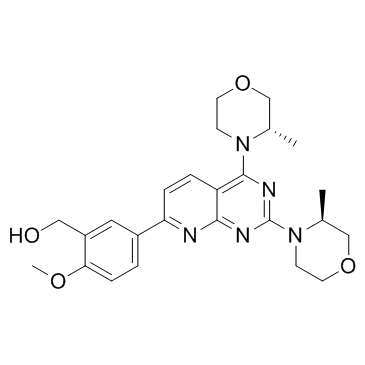1009298-09-2
| Name | (5-(2,4-Bis((S)-3-methylmorpholino)pyrido[2,3-d]pyrimidin-7-yl)-2-methoxyphenyl)methanol |
|---|---|
| Synonyms |
AZD-8055
Benzenemethanol, 5-[2,4-bis[(3S)-3-methyl-4-morpholinyl]pyrido[2,3-d]pyrimidin-7-yl]-2-methoxy- AZD8055 (5-{2,4-Bis[(3S)-3-methyl-4-morpholinyl]pyrido[2,3-d]pyrimidin-7-yl}-2-methoxyphenyl)methanol [5-[2,4-bis[(3S)-3-methylmorpholin-4-yl]pyrido[2,3-d]pyrimidin-7-yl]-2-methoxyphenyl]methanol |
| Description | AZD-8055 is a novel ATP-competitive inhibitor of mTOR kinase with an IC50 of 0.8 nM. AZD-8055 inhibits both mTORC1 and mTORC2. |
|---|---|
| Related Catalog | |
| Target |
mTOR:0.8 nM (IC50) mTORC1 mTORC2 Autophagy |
| In Vitro | The inhibitory activity of AZD-8055 (AZD8055) against mTOR is evaluated using two different assays. Using the truncated recombinant mTOR enzyme, the IC50 for AZD8055 is 0.13±0.05 nM. Using native mTOR enzyme complexes extracted from HeLa cells, the IC50 is 0.8±0.2 nM. AZD-8055 shows excellent selectivity (~1,000-fold) against all class I PI3K isoforms and other members of the PI3K-like kinase family. AZD-8055 inhibits the phosphorylation of mTORC1 substrates p70S6K and 4E-BP1 as well as phosphorylation of the mTORC2 substrate AKT and downstream proteins. The cellular IC50s for AZD8055 are calculated as 24±9 nM (n=13) for pAKT Ser473 and 27±3 nM (n=12) for pS6 Ser235/236 in MDA-MB-468 cells[1]. |
| In Vivo | In mice bearing U87-MG (PTEN null) glioblastoma xenografts, oral treatment with AZD-8055 (AZD8055) results in a dose-dependent tumor growth inhibition of 33%, 48%, and 77% with 2.5, 5, and 10 mg/kg/d twice daily, respectively. A similar dose dependency is observed in nude mice bearing A549 xenografts: tumor growth inhibition is 44%, 55%, and 93% after 2.5, 5, and 10 mg/kg/d twice daily, respectively. AZD8055 also results in significant inhibition of tumor growth and/or regression in breast, lung, colon, prostate, and uterine xenograft models when administered either twice daily at 10 mg/kg or daily at a dose of 20 mg/kg[1]. AZD8055 markedly decreases the phosphorylation levels of mTOR and its substrates and the activation of microglia in vivo, and promotes the microglial polarization from M1 phenotype to M2 phenotype. In addition, administration of AZD8055 following subarachnoid hemorrhage (SAH) significantly ameliorates EBI, including neuronal apoptosis, neuronal necrosis, brain edema and blood-brain barrier permeability[2]. |
| Kinase Assay | Inhibition of mTOR is evaluated using two methodologies: The high-throughput assay uses an α screen capture complex technology with a recombinant truncated FLAG-tagged mTOR (amino acids 1362-2549; expressed in HEK293 cells) and a biotinylated p70 peptide substrate. In addition, native mTOR activity is assayed using immunoprecipitation of full-length mTOR from HeLa cytoplasmic extract, and the endogenous mTOR is in protein complexes with Rictor and Raptor. A kinase assay is performed in the presence of recombinant 4E-BP1 protein as substrate with detection of the phosphorylated product through an ELISA format. The activity of the lipid kinases, class I PI3Ks α, β, δ, and γ, is measured using recombinant PI3Ks with the lipid PIP2 as substrate. Assays for the ataxia-telangiectasia mutated (ATM) and DNA-PK are performed. Finally, counterscreen against 260 kinases is carried out at a fixed concentration of 10 μM AZD-8055[1]. |
| Cell Assay | For growth inhibition and acridine staining, cells are exposed to increasing concentrations of AZD-8055 (0 to 1,280 nM) for 72 to 96 h and stained for cell nuclei (0.03 mg/mL Hoechst 33342) and acidic vesicles (1 μg/mL acridine orange). Images are captured at 450 and 536 nm on an ArrayScan II platform, and the percentage of acidic vesicles and the number of cells are quantified. For LC3 assessment, cells are exposed to e64d/pepstatin (10 μg/mL) for 30 to 90 min before incubation with AZD8055. Cells are lysed on ice and analyzed by immunoblotting[1]. |
| Animal Admin | Mice[1] Tumor cells (106 for U87-MG, 5×106 for A549) are injected s.c. in a volume of 0.1 mL, and mice are randomized into control and treatment groups when tumor size reach 0.2 cm3. AZD-8055 is administered by oral gavage (0.1 mL/10 g of body weight) once or twice daily. The control group receive the vehicle only. Tumor volumes (measured by caliper), animal body weight, and tumor condition are recorded twice weekly for the duration of the study. The tumor volume is calculated. Rats[2] Sprague-Dawley (SD) rats (250 g) and pregnant SD rats (16-18 days gestation, used for microglia extraction) are used. In experiment 1, 48 rats (54 rats are used, 48 rats survive after the surgery) are assigned randomly to four groups: sham group, SAH 3 h group, SAH 24 h group, SAH 72 h group. The animals in SAH 3 h, 24 h and 72 h groups are subjected to experimental SAH and are killed at 3 h, 24 h and 72 h after blood injection, respectively (n=12 for each group). In experiment 2, 72 rats (83 rats are used, 72 rats survive after the surgery) are assigned randomly to sham group (n=18), SAH+vehicle group (n=18), SAH+Rapamycin group (n=18), SAH+AZD8055 group (n=18). The rat receive a single intraperitoneal injection of Rapamycin immediately after induction of SAH, the dose of Rapamycin used is 150 μg/kg body weight. AZD8055 is administered by oral gavage with the dose of 14 mg/kg body weight. Rats in vehicle group are treated with equal volume solvent. All the rats in experiment 2 are killed at 24 h post-SAH. In experiment 3, enriched microglia are distributed into 5 groups: Control, OxyHb, OxyHb+vehicle (DMSO), OxyHb+Rapamycin and OxyHb+AZD8055. Twenty-four hours after microglia re-seeding, cells are treated with OxyHb (10 μM), DMSO (volume equal to Rapamycin and AZD8055), Rapamycin (2.74 mM), AZD8055 (0.8 nM) respectively in fresh medium. After incubation for 24 h (in 37°C, 5% CO2), cell medium is removed, washed by PBS for 3 times and fixed by 4% paraformaldehyde. |
| References |
| Density | 1.2±0.1 g/cm3 |
|---|---|
| Boiling Point | 694.3±65.0 °C at 760 mmHg |
| Molecular Formula | C25H31N5O4 |
| Molecular Weight | 465.545 |
| Flash Point | 373.7±34.3 °C |
| Exact Mass | 465.237610 |
| PSA | 93.07000 |
| LogP | 0.27 |
| Vapour Pressure | 0.0±2.3 mmHg at 25°C |
| Index of Refraction | 1.609 |
| Storage condition | -20°C |
| Safety Phrases | 24/25 |
|---|
